|
|
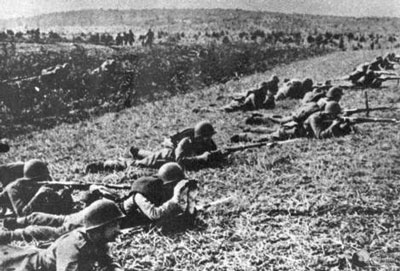 |
Polish Units in Exile
by Heath Alexander
As early as mid-September, 1939, Marshall Edward Rydz-Śmigły, Commander-in-Chief of the Polish armed forces, foresaw the importance of having a viable evacuation route out of Poland. This evacuation route, the so-called Romanian Bridgehead, became even more important on September 17th, when the Soviet Union invaded Poland from the east.
|
As two fronts converged on Warsaw and central Poland, the order was given that all Polish forces east of the Vistula River were to withdrawal to Romania, a former ally but now neutral in the face of Nazi aggression. Over 120,000 servicemen made the trek south into Romania and beyond to form units in exile that would eventually fight in every theatre of the European War.
Norway
Outmaneuvered in Scandinavia, the Allies were beaten to the strategic Norwegian port at Narvik by the Wehrmacht in April, 1940. A British task force, including two Polish destroyers, managed to seal off the city from the sea while the Norwegians, French, and Poles prepared an overland assault.
|
The Polish Independent Highland Brigade was tasked with assaulting German Gebirgsjager troops dug into the mountains overlooking Narvik while the Norwegians and French stormed the city proper. The retaking of Narvik turned out to be an exercise in futility, however, as the rest of Norway was falling to the Nazis. In what would become the norm for the early years of the war, the Polish were called upon to cover the retreat of her allies; the Highland Brigade suffered mightily before being withdrawn to France.
France
Despite being left to fend for themselves by the French in the autumn of 1939, most of the Polish forces that escaped through the Romanian Bridgehead made their way to France during the intervening months of the Phony War. Eager to share their experiences against the Nazis and get back into the fight against Germany, the Poles were initially welcomed as brothers-in-arms in the approaching conflict. This sentiment was not long-lived, however, as public sentiment soon turned against the newcomers. Many in French society, including the military, began to see the Poles as provocateurs in this new war, partially because they went against French and British advice to mobilise the previous September.
|
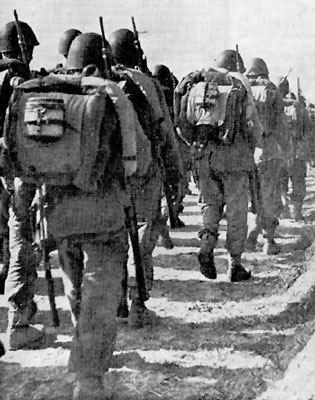
|
Some 85,000 Polish soldiers and airmen made their way to France in the waning months of 1939 and first half of 1940. Training and headquarters facilities were located in the west of France, near the towns of Parthenay, Poitou-Charentes and Guer, Brittany. Władysław Sikorski, the newly appointed Prime Minister of the government-in-exile and Commander-in-Chief of the Polish Armed Forces, began the process of organizing his rag tag band of evacuees. Four infantry divisions and two independent brigades were formed to help bolster the French war effort although the Polish contributions were short-lived due to the rapidity of the French collapse.
Ironically, the 1st Grenadier Division was stationed in the Saar, the only territory taken by the French during their invasion in 1939. Attached to the French 20th Corps, General Bolesław Duch’s 1st Grenadiers were stalwart defenders that refused to retreat when ordered in early June, 1940. Holding the line until the French were safely away, the division finally withdrew on June 21st, down to 55% of their original fighting strength.
|
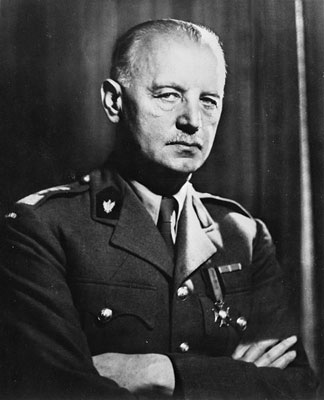 |
The 2nd Rifle Division was posted in Belfort, just north of the Swiss border and commanded by General Bronisław Prugar-Ketling. Fighting alongside the French 45th Army, the division sought to retreat into Switzerland once their position became untenable. Unfortunately for Prugar-Ketling, the Swiss, in keeping with their neutrality, interred the entire division and no significant portion of it saw further combat.
The Polish Independent Highland Brigade defended the Channel Coast near Brittany until it was evacuated piece-meal from the field after being overwhelmed. Only partially mustered, the 3rd Rifle Division refused the French order to surrender to the approaching Germans and fought a holding action after the Highland Division was overrun in Brittany before being withdrawn to England. While the 4th Rifle Division was fully formed and equipped, it was also ferried across the channel before gaining any combat experience.
|
Perhaps the most notable unit reconstituted in France was the 10th Armored Brigade, the so-called Black Brigade. Sent to Champagne to provide much needed mobility to the French 7th Army Corps, General Stanisław Maczek’s unit acquitted itself with distinction. During successive engagements the Black Brigade covered the retreat of the French 20th and 2nd Divisions before being ordered on the offensive. Coupled with the French 42nd Division, the 10th attacked the German positions at Montbard with combined arms that carried the battle. Even after suffering 75% casualties and enduring some of the most brutal fighting in France, the Black Brigade still managed to breakout across the Burgundy Canal towards evacuation across the channel. These escapees would later form the core of General Maczek’s 1st Armoured Division that would return to France after D-Day and help liberate most of Western Europe.
|
North Africa
Allied fortunes were at their nadir in North Africa during the spring and summer of 1941. The “Desert Fox”, General Erwin Rommel had led his Afrikakorps to the very gates at the coastal fortress of Tobruk, Libya. An invaluable supply port, Tobruk was to be held at all costs until a counterattack could be launched from Egypt. The Australian 9th Division maintained a tenuous grip on the Tobruk defenses for five months in the face of several German and Italians attacks. The Aussies valiantly held their positions despite irregular supply lines and infrequent reinforcements.
|
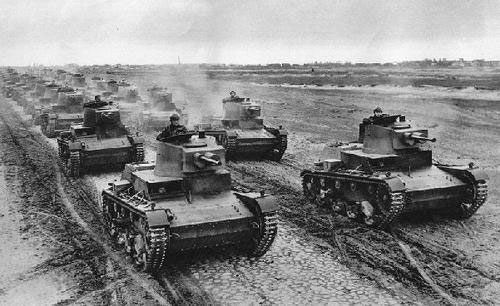 |
That changed in mid-August, 1941, when the men of the Polish Independent Carpathian Rifle Brigade disembarked from their transports in Tobruk harbor.
Newly equipped by the British in Palestine, the Polish Independent Carpathian Rifle Brigade (Samodzielna Brygada Strzelców Karpackich, or SBSK) arrived in Tobruk on August 18th, much to the surprise of the beleaguered Australians. Strangely enthusiastic to be in North Africa at the height of summer, the troops of the SBSK quickly endeared themselves to their new comrades. As the Australians learned of the plight of the Polish soldiers over the last two years, they developed a healthy respect for the Poles’ desire to engage the Germans early and often. The area around Medauar Hill, a strategically important high point, was notoriously hard to defend against infantry attacks and neither side had managed to hold it for more than a month to that point. Opposed by the Italian 17th Infantry Division, the SBSK took the area, known as The Gap, in a series of daring night attacks and managed to hold it for the two and a half months until Operation Crusader. |
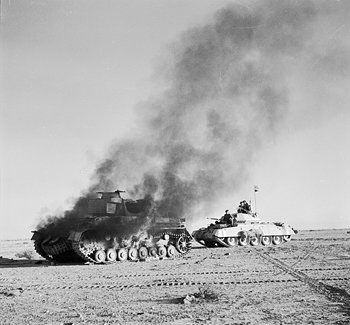 |
Three months to the day after the Polish arrival at Tobruk, the British 8th Army launched Operation Crusader from Egypt. In their attempt to link up with the defenders of Tobruk, the British managed to catch Rommel wrong-footed for all of two days before he halted the offensive at Sidi Rezegh, Libya. Although the main thrust had been stopped short, Rommel now found himself in an untenable position. Word had gotten to Tobforce about Crusader and a break out was planned for the night of November 20th. Originally slated to be the diversionary force in the sector around Medauar Hill, the Carpathian Brigade attacked with a ferocity that belied their tactical role. Supported by the 1st Artillery Regiment, the Poles crossed open desert and overran their Italian opponents in hand-to-hand combat.
|
Tobforce and 8th Army managed to establish a tenuous position in the Libyan Desert at El Duda that soon became the focus of Rommel’s next counterattack in early December. If not for the skill of two Polish artillery batteries supporting British infantry and armor the efforts of the previous month might have been for naught. This final stand was enough to turn the tide against the Germans in North Africa. Recognized for their contributions to the defense of Tobruk and the breakout to link up with the 8th Army, the Carpathian Brigade was put at the head of the final assault on Gazala in Mid-December. Being given the honor of leading an assault would become a recurring theme for Polish forces fighting across the many operating areas in the European theatre of war.
|
The Soviet Union
Estimates vary wildly regarding the number of Poles interred in the Soviet Union after the September invasion; anywhere from 250,000 to 1,500,000 refugees were sent to labour and prison camps scattered across the length and breadth of Mother Russia. Many were worked to death and many more were worked to near death. Such was Stalin’s desperation after the Nazis launched Operation Barbarossa in June 1941 that when his erstwhile Allies crossed the Curzon Line he ordered the release of most of the Polish captives and had them sent to muster stations to prepare for mobilisation.
|
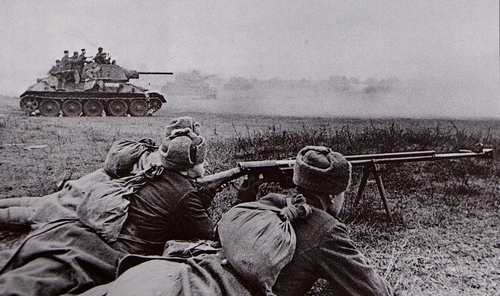 |
| Having subsisted on barely 1,000 calories to get them through their 12-14 hour work days, the Poles were hardly in a condition to contribute to the Soviet war effort so soon after gaining their freedom. Moscow and the Polish government-in-exile wrangled over who should nominally be in charge of this Polish Army on Russian soil. Mid-August saw the formalisation of the agreement allowing for the formation of a 30,000 strong force placed under the command of General Władysław Anders. |
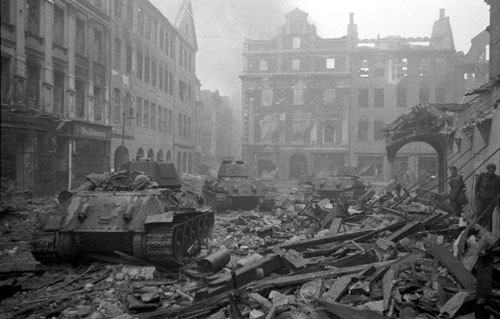 |
Worth noting is the fact that not every Polish soldier in the Soviet Union chose to leave with Anders. Zygmunt Berling deserted his post as Chief of Staff of the 5th Infantry Division to stay in Russia and serve Stalin, for which he was rewarded with promotion to General and command of the 1st Tadeusz Kościuszko Infantry Division, a founding unit of the Polish People’s Army. Although native Poles filled out the ranks of the units loyal to the communist cause, the officers were typically Russian to ensure loyalty to Stalin and the Commissariat. |
The Soviets recognised a political opportunity when they saw one and were more than happy to exploit the Polish Forces in the East, especially once the Katyn Massacre came to light and the Polish government-in-exile broke off contact with Moscow. The Polish forces under Soviet auspices eventually grew to two Armies, one commanded by Berling and the other by Karol Świerczewski, that were instrumental in liberating Poland and ensuring a post-war communist regime.
All in all, over 100,000 Polish soldiers and civilians managed to escape the gulags and make their way into the hands of the western Allies. These soldiers would spend the better part of the next year moving all over the British controlled Middle East training and recuperating from their Siberian ordeal. Eventually, in late 1943, the Polish 2nd Corps would find itself ashore in Italy, at the bloody tip of the offensive to liberate the Soft Underbelly of Europe.
Polish fighting men and women, after the initial invasion by the Germans, brutal mistreatment by the Soviets and apathetic neglect from the French, had every right to roll over and wait for the Allies to come to their rescue. Instead, the Polish people made every effort to rejoin the fight against their occupiers and were highly valued by their comrades for their tenacity, ferocity and skill at arms.
~ Heath.
|
Want To Know More About Blitzkrieg?
Over the past few months we have added a massive range of articles about Blitzkrieg to the website, to make it easier for people to find a specific article we have put together this handy place.
Find out more about Blitzkrieg and Early-war here... |
Last Updated On Monday, April 18, 2011 by Chris at Battlefront
|
|